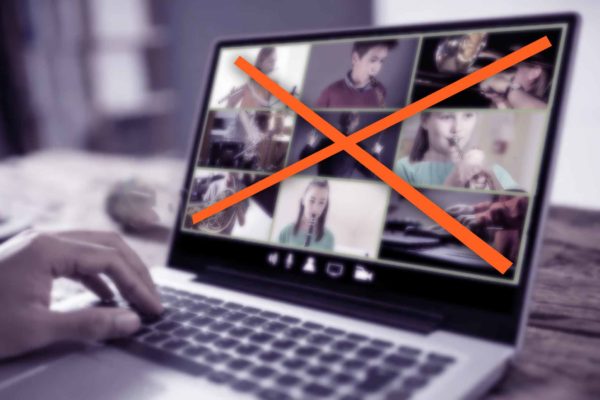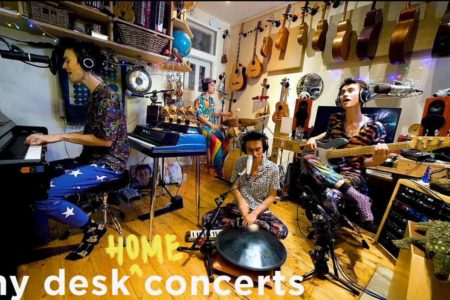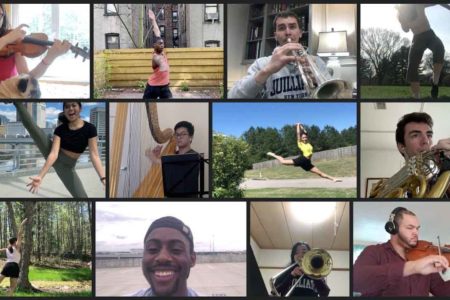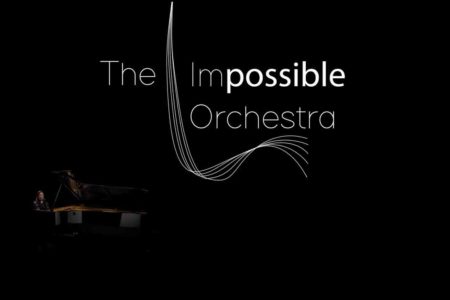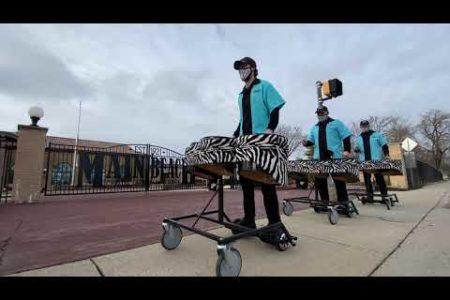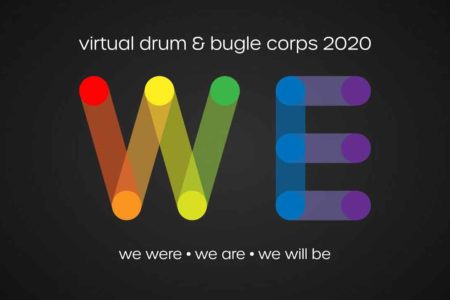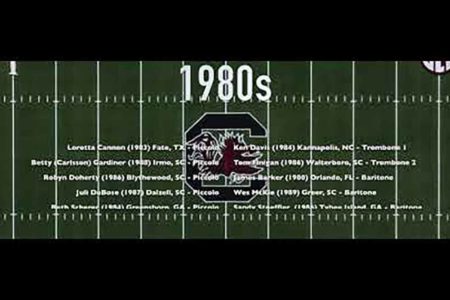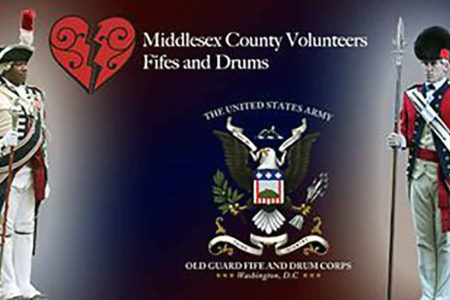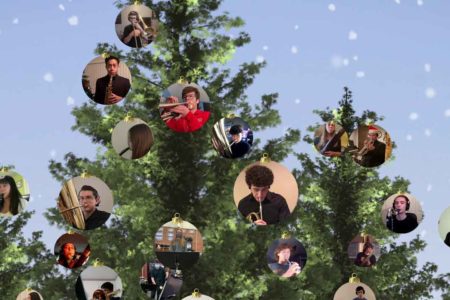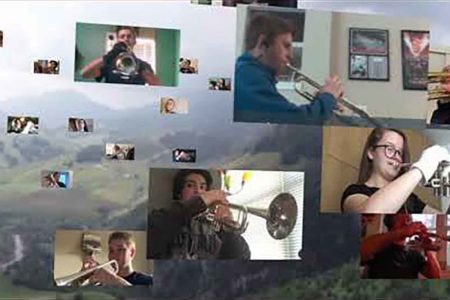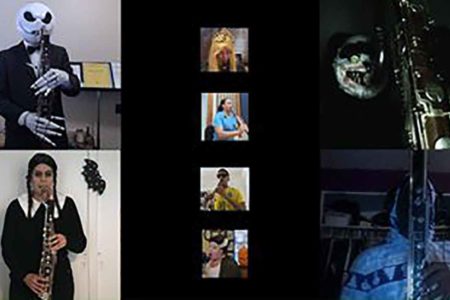When radio started, actors recited theater shows. When tv started, they broadcast footage of radio dramas.
Anytime a new medium emerges, it starts by copying its predecessor.
And so do virtual band videos… for now.
Ask any band or chorus director. Operating a performing arts ensemble remotely is not the same as doing so in-person.
But some directors try to make it that way. They seem to be looking for virtual versions of their favorite in-person methods.
That’s the wrong answer.
The wrong way
You’re (probably) doing Virtual Band videos wrong.

There are some good examples out there. But lots of the virtual band videos we’ve seen are making a huge mistake.
Band and chorus directors from schools around the globe headed home at the start of the pandemic.
You can tell by the google searches:
- how to create a virtual band video
- virtual marching band ideas
- how to record virtual band
- band class covid
- band class coronavirus
EVERYONE is wondering about this right now, and with good reason.
But too many directors fired up their favorite video conferencing app, and started working on a “Brady Bunch-style” rectangle grid performance video.
But that’s just an in-person band converted to a virtual medium. There’s A LOT more that truly virtual bands could be doing.
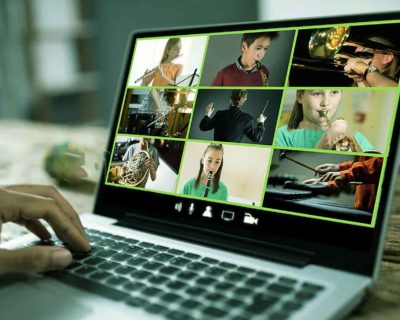
An analogy: marching band & chamber music
Imagine if a 300-member marching band performed some classic chamber music—maybe some vintage Haydn or Mozart.
Now let’s imagine that this band performed Haydn as written. (Ignore the obvious instrumentation mismatch for now.)

If they played it as written, it would be performed with one per part. 300 members in the band, but only 4 of them play in each piece.
No one would hear the gorgeous affettuoso expressions. Intricate arpeggios would likely be wildly out-of-time, since performers are no longer sitting next to each other.
It just wouldn’t work.
And band arrangers know this. So they create a new composition based on Haydn’s Op. 20 #4, but with significant changes made in order make it work for the ensemble and the setting in which it’s performed.
Performance must adapt to its medium.
The same is true for virtual band performance videos. It’s still the same ensemble. But the performance venue is wildly different.
Adapt your band’s performance for its new virtual venue. In the next section, we’ll talk about how.
Consider the medium
Performance must fit its medium.
You can’t fit a square peg in a round hole. And you can’t put a marching band on Zoom and call it a performance.
There’s more to it than that. Here are some facts* (jk, they’re opinions) about improving your virtual band and chorus videos.

Innovate
Let’s start at the top. Think outside the box and get creative about what your finished product could look (and sound) like.
Look what props and costumes did for the marching idiom. Or asymmetrical drill, grounded instruments, and electronics before that.
Today’s DCI shows are unrecognizable compared to the VFW days of yore— the game has changed.
Competitive groups got tired of the same old same old, and they got creative. You need to do the same.

Fresh twists on old tricks, or something totally new
Face paint? Why not. Slow-mo or FFW effects? Sure. Dialog?? We can do that now.
People, there are no rules. You can literally do anything you want. Want to show a rifle toss off a rooftop? You can do that!
Don’t use Zoom/Google Meet.

Speaking only of the Covid pandemic, the rules don’t say you have to stay in your house.* (or maybe they do?)
As long as you’re not violating public health regulations (masks, social distancing, etc), there’s nothing wrong with getting out of your house.
Some groups have chosen to use the same place, but at different times.
But the point here is: it’s a video—NOT a video conference. You don’t need to be on a video conference at the same time. And you definitely don’t need to use video conferencing software to record.
Zoom is for conferencing. Not for videos. Use Quicktime on a Mac or the built-in Camera app on a Windows PC. Or the equivalents on smartphones or tablets.
It doesn’t have to be “marching” band.
It’s virtual band, remember? Unless you get a videographer decked out in a FLYCAM stabilizer vest, you’ll have a hard time showing off individual performers marching around.

So let’s put the marching part aside for now. Not forever. Just for now.
It’s basically a music video.
Are you old enough to remember that crazy Jamiroquai music video from the 90s? At the time, this video was INSANITY (only the fans will see what I did there).
When everyone else was making the same old same old music video on MTV (it was the 90s, after all), here comes this British funk group changing everything to make an INSANELY good video.

The video was so popular that it helped make Jamiroquai’s album the best-selling funk album of all time.
That’s the power of a music video.
Put it another way — Don’t be Hamilton. Be Hamilton on Disney+
Hamilton on Disney+, or Hamilfilm if you’re hip, is actually 4 different performances edited together — BECAUSE IT’S VIDEO AND YOU CAN DO THAT.
Do you think they could get extreme close-ups like this during a regular live theater performance? No way.
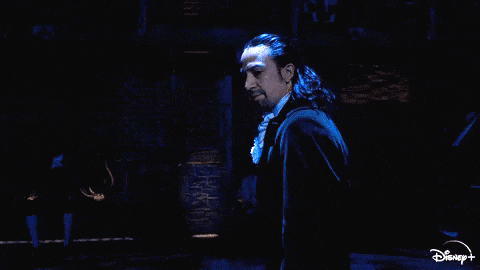
All those close ups you see in Hamilfilm were shot during a private dress rehearsal with no audience—just an up-close and personal camera crew.
What would that mean in your case? It probably means “ok everyone, record yourselves at home and send me the video by Friday” won’t cut it.
Instead, it should be something more like “Trumpet 1, be at the football field at 1pm to play your part. Trumpet 2, be there at 1:15…”
Safe, socially distant, and entirely editable to be compiled into one awesome video product.
Show themes take on a whole new meaning.
You’re no longer limited to props and costumes to convey your show concept, theme, characters, or plot.

Doing a maritime theme for your show? Now you can literally go to the ocean and perform your music there.
Use a boat as a backdrop—a real, actual boat. You don’t have to worry about transporting it to every show, or wheeling it onto a football field anymore.
That means you can get so much more creative with props and backdrops.
- Doing a space show? Film at night, under the stars.
- Doing a sci-fi show? Borrow parts from your school’s Robotics team
- African safari theme? Go to the zoo with actual animals.
The possibilities are endless.
Design it.
Approach a video project design similarly to the way that they might look to design a field show
Get your the creative staff involved.
They might not be expert cinematographers, but they’ll definitely have some input on things like “the trumpets have to be featured at this spot,” which will guide your overall video arc.

Your visual and concept design people will probably love this opportunity. They can now use all kinds of different settings and items to help tell their story through your performance.
Involve your students! Get their input.

They will feel WAY more ownership this way. It takes their contribution out of “sit there and play this” into “create something together.”
As with all things your students suggest or submit, you’ll need to curate and approve their ideas, but they can be really helpful and creative.
Also, let’s be real… they already make and publish way more videos than you do. They can actually be really helpful here.
Opportunity
New medium = new opportunity.
Now that your performance is entirely video-based, the rules are totally different. And so are the possibilities.
All bets are off. You don’t have to do any of the things you used to. Ever wanted to push the envelope and experiment a bit? Now’s your chance.
- Who says it has to be done in the fall?
- Who says you have to do only one “show” or theme in a given school year?
- Who says all the performers have to be on the same continent?
- Why not ask your alumni to perform too?
- Why not ask Dionne Warwick or Mike Mangini to contribute?
There are no rules. There’s one rule.
What is a band performance, anyway?
Sure, it’s the exhibition required by your state’s Department of Education or your district’s Curriculum Director.

But it’s more than that.
It’s the payoff for weeks or months of your and your students’ hard work.
And if it’s the payoff for your students’ hard work, shouldn’t they be rewarded in a way that feels meaningful to them?
Have you met a teenager lately? I absolutely guarantee that 100% have uttered the phrase “make it content.”
Make it content.
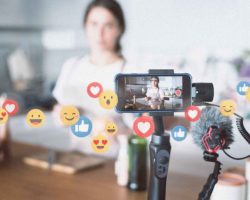
These performances are no longer just the exhibition of skills learned by your students after X number of practice hours.
They’ve evolved into experiences that can be shared (read: both enjoyed, and posted online) by anyone, anywhere—especially by the teenagers in your ensemble.
That means they’re bigger than just your school or your students — and they can accomplish things for you that a high school auditorium or football stadium performance never could.
Virtual band video = recruiting tool
Every band program is worried about recruitment. Every director has googled stuff like “how to recruit for marching band” at least once.
And usually on those ‘how to recruit for band’ articles, the authors recommend making a video— WELL NOW YOU’RE MAKING VIDEOS.

When you’re planning your virtual band performance video, include recruitment on list of goals. Jury’s out on whether “will 8th graders think this is cool?” is the right way to do that.
The truth is I have no idea what an 8th grader will think is cool, and neither do you. And it wouldn’t matter anyway because they probably think TikTok is the meaning of life.
But here’s what does matter for band recruiting:
If it’s not a video, they probably won’t see it at all. So the purpose of the video, as far as recruiting goes, is simple: “did the 8th grader watch it at all?”
You don’t have to blow their hair back. But you do have to get their attention. That’s what this video is for.
Cue the alumni.
Your alumni want this.
You’re always looking for ways to get your alumni involved, right? This is perfect.

Does your college call, mail, and email you incessantly? Of course they do. Know why? Because alumni are crucial for every program—including yours.
Colleges usually have an easier time engaging active alumni than high schools do. But high school should learn from colleges.
Alumni usually care more about their favorite program than about the school itself.
That means that individual programs—like arts or athletics—probably have an easier time engaging alumni than a general CityTown High School Alumni Association would.
Here’s where you come in.
In your case, band alumni probably love their memories and high school band friends. And they’d probably respond favorably to outreach efforts by the band/arts program.
Secret weapon #1: alumni engagement
What would you do if you had 100+ motivated, loyal alumni ready to help your program? Lots of stuff, right?

You’d probably invite them to events. Ask them for money. Snag them as free volunteer labor? Maybe hire some of them to teach?
Alumni are the backbone of a strong program.
And what better way to get your alumni involved? Let them perform with you all over again!
Lots of groups do this with “bring your horn for homecoming” sorts of events. My band invites alumni back to play at the winter holiday concert every year.
These events are always a huge success— on 2 conditions:
- When they happen at all (thanks, covid)
- When the alumni are geographically and emotionally close enough to the program
But imagine if that geography requirement disappeared. You could involve alumni from all over the globe to submit their own video and be featured in your next virtual performance.
This is absolutely HUGE for keeping your alumni engaged!
Secret weapon #2: alumni fundraising
There are a thousand reasons to keep your alumni engaged, and most of them are money. Here are some great ways to use these videos to raise money from your alumni.
Put them in the video and they’ll help you pay for it

Providing your alumni with a deliverable lets you give something back— things like virtual performances, but also things like band camp photos, staff interviews, etc.
The unwritten understanding is:
“We wouldn’t be here without you. And we still need your help to do these cool things.”
And what better way to get their help than to ensure they get to enjoy the payoff first-hand?
All it takes is a “we want you to be in our next video!” and then a quick “we need your help covering costs” to hook ’em.
Sure, not every alum will want to participate and donate, but the number will be more than zero.
10%? 5%?
Even just a handful of alums could chip in to cover any virtual band video production costs— and it costs you nothing extra to include them in the finished product.
And as an added bonus, these alumni are far more likely to recruit their friends among other alumni to contribute next time.

Video as bait: PBS-style “thon” event
There’s a reason PBS and NPR do their famous pledge drives every year — they work. But there’s another reason, too.
These are media/broadcast companies. What tools do they have available to use for projects like fundraising?
Audio/video content.
Without live/in-person events that’s what you have, too — virtual performance audio/video content.
So the trick is to transform your video into an event. Eric Wittacre is phenomenal at this, by the way.

Reach out to your alumni well in advance of your video’s debut. Like, months in advance.
Debut the video live and in real-time as an online “watch party.” Use the available social media and email tools to promote the event, collect signups, and build buzz.
Before, during, and after your live-streamed video event, include calls to action asking viewers to donate.
In a sense, the video is the bait that lets you capture their attention. While you have their attention, ask them for money!
Inspiring examples
Where to draw inspiration from
Ok, so it sounds great. But you have no idea where to start, and you’re looking for examples. Right?

Literally every video. Your virtual band video needs to be a music video, or a movie, or a soap opera if you’re into the drama scene.
But pay attention to how the Grammys record their live performances, for example.
Sure, they have crazy lights and pyrotechnics, but that’s not what I mean.
Watch how they focus on a few performers at a time, then they zoom out and show everyone. Then come in close for a solo. Then get some crowd reactions.
These are all tactics that your virtual band video can deploy (yes, even crowd reactions).
1. Jacob Collier Tiny Desk
THIS is how you make a virtual performance video! And it should come as no surprise that one of the most talented creative musicians in the world gave us the #1 video.
This video was published by NPR, but it was performed, recorded, and edited entirely by 26 year old Jacob himself.
What we like about it
I mean… everything? The music is incredible, of course. But the video is SO well done. It’s edited together seamlessly and it’s simple yet captivating from start to finish.
Think of how easy it would have been for Jacob to put 4 static panels side by side. Easy, but boring. Instead, he invested in the time and effort to create a gorgeous finished product worthy of an internationally-renowned publisher like NPR.
Absolute gold.
| Creator | Jacob Collier/NPR – London, UK |
|---|---|
| Format | Single-camera |
| Editing/Fx | Heavy |
2. Bolero Juilliard
Simple technology. Mind-boggling coordination. And celebrity cameos! This video is off the charts. And you’d expect nothing less from Juilliard.
The whole thing is done on everyone’s favorite video collaboration tool: Zoom. But unlike 100% of other Zoom virtual performances, this video doesn’t suck—just the opposite, in fact.
What we like about it
Everything, especially Bradley Whitford looking exasperated and Laura Linney brushing her teeth. On first view, it looks like everyone recorded themselves at home, performing along to the same master track.
But if you watch the blooper reel at the end, you can catch a few glimpses of their choreographer rehearsing (or recording?) with several dancers at the same time—live.
Add many, many hours of video editing after the fact, and you have an incredible performance by exactly the institution you’d expect.
| Creator | The Juilliard School – New York, NY |
|---|---|
| Format | Solo / Various |
| Editing/Fx | Heavy |
3. Great Locomotive Chase
This video is what started the whole “hey we should help people plan their virtual performance videos” idea for us. This is just so damn creative!
This is the first video I saw that really opened my eyes to the possibilities for high school marching bands and their virtual performances.
Even Robert W. Smith, the composer of the piece, was in awe of Easton High School’s performance.
What we like about it
This video completely breaks the mold of a “virtual performance.” It’s an in-person performance, that shares the same space but, due to social distancing, at different times.
Beyond the creativity of changing the space and time restrictions, the video tells a story. Suddenly, viewers are 100% invested in the orange-clad percussionist’s journey. We’re transported from watching to participating.
This is my #1 favorite way to create a virtual performance!
| Creator | Easton High School – Easton, MD |
|---|---|
| Format | On-site |
| Editing/Fx | Moderate |
4. Fly to Paradise
Whoaaaaaa this video is insane! Clearly professional, and with good reason. Eric Whitacre is a big league pro, and his Virtual Choirs are the real deal.
I can’t even imagine how much editing went into a video like this. I’d love to know what it cost to produce! Yet another reason to fundraise for your marching band.
What we like about it
The consistency of feeling is clear. Despite containing 8,409 separate videos from 5,905 singers, the video feels cohesive and unified—no small feat!
I have to admit, I think the animated winged girl is a little creepy, but credit where it’s due— this is a volunteer performing arts ensemble whose creator commissioned an entire animated film just to showcase singers from around the world.
The evolution of Whitacre’s Virtual Choir is impressive, and relevant to anyone looking to create a virtual performance video.
Notice how it starts with creatively-arranged rectangles and quickly grows beyond that limitation into a standalone piece of creative musical entertainment.
Here’s the sequence:
Virtual Choir 1 • 2 • 3 • 5 • 6 • 7 • and a TED Talk explaining the initiative.
| Creator | Eric Whitacre (Online/virtual) |
|---|---|
| Format | Animated |
| Editing/Fx | Extreme |
5. Star-Spangled Banner
This is probably the most famous virtual performance in recent months—viewed by millions of Americans at the same time. It’s a standard “rectangles” setup, but two important factors that make it better than most.
Rectangles are in portrait mode, which fits the singers’ shape/size better, and it removes wasted space, allowing more people into the frame at once
They’re all wearing coordinated colors, and they all shot on a white wall background. Consistency is key!
What we like about it
I mean, for one thing, it’s a choir of regular people who got to sing our national anthem for the nomination of the president—so that’s pretty awesome.
And it’s a great example of what virtual performance videos can be—creative, fun, and beautiful. And with the potential exception of the stars transition at the end, it’s not really THAT much editing!
| Creator | 2020 DNC Convention (Online/virtual) |
|---|---|
| Format | Rectangles / Solo at home |
| Editing/Fx | Heavy |
6. No Place Like HoMe
Lots of college marching bands went virtual in 2020, and many published virtual performances. Then there’s Michigan. This video is above and beyond. They animated the Big House!
If all college marching bands did virtual performances like this, the world would catch fire with newfound enthusiasm for marching arts at the collegiate level.
What we like about it
It starts out pretty standard. But within seconds, they establish a really cool motif— performers “marching” or moving through the video frame. And it all just keeps getting better from there.
By about 1:30, the momentum of the video starts building toward something. 10 seconds later, we hit the payoff:
Performers are edited into a an animated version of Michigan’s famous “Big House” stadium.
Fitting for the title of the video: No Place like Home—the stadium is the Michigan Marching Band’s home. The video is complete with a gameday voiceover, an animated crowd and cheerleaders, and even a “Go Blue” banner animated airplane flyover.
The attention to detail on the semi-animated sequence of this video is absolutely incredible.
And we end with a familiar Zoom-style grid of 221 band members (yes, I counted) playing their fight song. A+ all around on this video!
| Creator | Michigan Marching Band – Ann Arbor, MI |
|---|---|
| Format | Solo / Various |
| Editing/Fx | Extreme |
7. Danzón No. 2
This is the most impressive professional production of the whole bunch. With corporate sponsors and an entire production and editing staff, Mexican powerhouse composer and conductor Alondra de la Parra created The Impossible Orchestra.
De la Parra was the first-ever female conductor for the Queensland Symphony Orchestra in Australia and her talents are not wasted on this phenomenal virtual performance of Arturo Márquez’s Danzón No. 2.
What we like about it
The production quality, first and foremost. It helps that the video features some of the most talented orchestral musicians in the world. But even with their talent, the video could have been a flop.
It isn’t.
The entire 15+ minutes, even the credits rolled at the end, are impeccably executed and designed.
The video features performers from 14 different countries, in order to support Mexican women and children affected by COVID-19 — and it is a wild success!
| Creator | The Impossible Orchestra (Online/virtual) |
|---|---|
| Format | Solo / Various |
| Editing/Fx | Heavy |
8. Quadzoom Quartet: Signed, Sealed, Delivered
There was mechanical engineering involved in this! It took me a while to figure it out, but it looks like those are hoverboards, attached to what appear to be custom-built rolling quad stands — genius!
The hardest part about this whole thing—other than welding a field frame, apparently—would be the drone footage used to shoot the video.
What we like about it
I love everything about this video. For starters, they have masks on. Clearly a safe, socially-distant method of getting performers together in the same place.
Wind players? Your mileage may vary.
But this is a perfect example of how it doesn’t have to be marching band anymore. It’s musical entertainment, so why not invest in some hoverboards??
| Creator | Crystal Lake Strikers – Crystal Lake, IL |
|---|---|
| Format | On-site |
| Editing/Fx | Light |
9. The Constant
Excellent example of where professional video editing and production can take you if all you have to work with are user-submitted home recordings.
| Creator | Virtual Arts, Inc. (Online/virtual) |
|---|---|
| Format | Rectangles / Solo at home |
| Editing/Fx | Heavy |
10. We
The original
| Creator | Virtual Arts, Inc. (Online/virtual) |
|---|---|
| Format | Rectangles / Solo at home |
| Editing/Fx | Heavy |
11. A Riverside Celebration
Very clever!
| Creator | Washington County School District – Washington County, UT |
|---|---|
| Format | On-site |
| Editing/Fx | Moderate |
12. The Nutcracker Suite
| Creator | The Riverside Swing Band – Marine St. Croix, MN |
|---|---|
| Format | Rectangles / Solo at home |
| Editing/Fx | Heavy |
13. USC Gamecocks Fight Song
Creative design
| Creator | USC Virtual Alumni Band (Online/virtual) |
|---|---|
| Format | Rectangles / Solo at home |
| Editing/Fx | Heavy |
14. Compilation
| Creator | US Army Old Guard Fife & Drum Corps – Washington DC |
|---|---|
| Format | Rectangles / Solo at home |
| Editing/Fx | Moderate |
15. Sleigh Ride
sdfsdfsdf
| Creator | Lafayette Wind Symphony – Lexington, KY |
|---|---|
| Format | Rectangles / Solo at home |
| Editing/Fx | Moderate |
16. Ukrainian Bell Carol
Clever use of christmas imagery
| Creator | Baldwin Pops – Fairhope, AL |
|---|---|
| Format | Rectangles / Solo at home |
| Editing/Fx | Heavy |
17. Disney Soarin’ Theme
Matching the feel of the tune
| Creator | Blue Stars Drum Corps – La Crosse, WI |
|---|---|
| Format | Rectangles / Solo at home |
| Editing/Fx | Heavy |
18. Santa Claus is Comin’ to Town
Meh again
| Creator | Terrible Adult Chamber Orchestra – Los Altos, CA |
|---|---|
| Format | Rectangles / Solo at home |
| Editing/Fx | Moderate |
19. Silver Bells
Meh
| Creator | Terrible Adult Chamber Orchestra – Los Altos, CA |
|---|---|
| Format | Rectangles / Solo at home |
| Editing/Fx | Moderate |
20. Danse Macabre
| Creator | Neo International Clarinet Ensembles (Online/virtual) |
|---|---|
| Format | Rectangles / Solo at home |
| Editing/Fx | Light |

